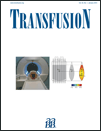Validation of human monoclonal HLA Class I antibodies to evaluate the kinetics of donor chimerism in different cell subsets after double-cord-blood transplantation in the NOD/SCID model
This work was supported by grant PPOC-06-030 of the Sanquin Blood Supply Foundation, The Netherlands.
Abstract
BACKGROUND: Double-cord-blood transplantation (DCBT) in patients is typically accompanied by predominance of a single unit. The causative mechanism, however, is unknown. Identifying the dynamics of mixed donor chimerism in general and in specific subpopulations may help to resolve this question. We conducted studies in a mouse model to develop a new analytic method using anti-human HLA Class I allele–specific monoclonal antibodies (HLA-MoAbs) in flow cytometry.
STUDY DESIGN AND METHODS: Single-cord-blood transplantation or DCBT from HLA-mismatched donors was performed in NOD/SCID mice. Bone marrow (BM) and peripheral blood were collected from 3 to 20 weeks after transplantation. Donor chimerism was determined quantitatively within human platelets (hPLTs), human CD45+ (hCD45+) cells, and human myeloid and lymphocyte subsets by flow cytometry.
RESULTS: Both cord donors stably engrafted in NOD/SCID. The sensitivity to detect chimerism measured with all HLA-MoAbs was 1% (>10 cells/µL). In mouse BM, the percentage of human cells measured with hCD45+ versus HLA-MoAbs correlated excellently (r = 0.999). Donor origin could be defined with HLA-MoAbs for nearly all (>93.6%) human cells in mouse peripheral blood and BM in all lineages. Chimerism of hPLTs in peripheral blood correlated well with hCD45+ cells in BM enabling frequent measurement of chimerism from early after transplantation onward.
CONCLUSION: This approach using HLA-MoAbs enables longitudinal analysis of double-mixed human chimeric populations despite low absolute concentrations of human hematopoietic cell subsets in peripheral blood and BM in mice. Lacking reactivity with mouse cells, the HLA-MoAbs are suitable for use in other mouse models and in humans to identify the mechanisms involved in DCBT.




